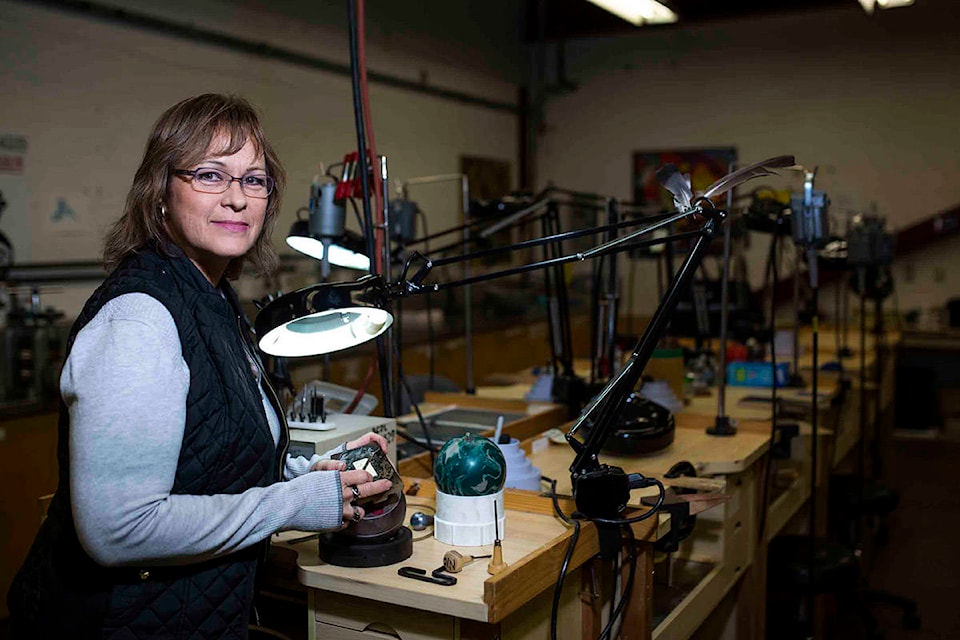For First Nation artist Leanne Helin, silversmithing has family ties. A member of the Tsimshian (pronounced SIM-shee-an) First Nation, Helin didn’t start working with jewellery until she was in her 20s. She apprenticed under her older brother, Bill, learning the art of engraving metal at their family business in Parksville.
Helin got very good at finishing pieces and when her brother saw her take an interest, he encouraged her to try engraving.
“It was cool to take all the First Nations animals and incorporate them into various pieces of metal,” she says. “My brother believed in me enough to encourage me to try even though I didn’t think I had any artistic skills.”
Metal smithing became something that allowed her to create something beautiful and connected Helin to her roots.
Her grandparents were Chief of the Gitlan tribe and Chieftaness of the Gitgeese tribe. Her father was chief Hy’emass of the Gitgeese tribal nation and married her mother who is of Norwegian descent despite her grandparents’ wishes.
“His parents were still trying to arrange the marriages and the bloodline,” says Helin. “My mother and father broke out of the tradition of arranged marriages that were still happening then.”
RELATED:
While Helin was born in Prince Rupert, she says her family moved to Vancouver Island when she was in elementary school. Her entire family is good with their hands. Her mom, she says, can paint and draw anything and can pick up any kind of sewing project.
“She’s very spontaneous,” says Helin.
But growing up, she didn’t think she was artistic.
“My older brother, he was talented as soon as he could hold a pencil,” she says. “If I did any art beside him, I was overshadowed by his talent. He got out of a lot of house chores because he was busy drawing.”
‘Every (piece) flows differently,” says Helin. “They all have their own personality.’ Photo by Marissa Tiel/Campbell River Mirror
But it was that older brother, Bill, who she apprenticed under. Her only formal training came from a week-long jewellery repair course through the Gemological Institute of America in California.
“It was really good exposure for me,” she says.
Now the bulk of Helin’s work is custom orders. Out of her she creates personalized pieces.
“When I’m starting to work on it for them, knowing their personal input, it evolves differently,” she says. “They mention little things that I try to remember if I have space left over.”
She enjoys using the Tsimshian crests in her work and always using two for balance.
“Something strong and something else keeping it respectable,” she pauses, “delicate.”
Helin is thankful she got her start with her brother learning how a finished piece should look and learned to design right on the metal.
“Every (piece) flows differently,” she says. “They all have their own personality.”
The pieces she creates aren’t that big, usually around an inch, with bracelets being the largest at about 1.5 inches wide and six inches long.
To create her pieces, she explains, the crests are kind of like puzzles. You start by putting the most obvious form – the head – on the metal and go from there, adding the animal’s distinguishing features. Then you keep adding until there’s no room left.
RELATED:
“That was challenging for me just to keep getting it the right space that it looks coordinated so [it] didn’t look totally juvenile.” she says. “It was a lot of practice.”
There were no online reference sites like Etsy or Pinterest and at the time, only a few books on native design existed.
“I was mostly just winging it,” she says. “Art and jewellery is always very forgiving. You can always add something to it.”
Helin has been a pioneer in the West as a female Indigenous jewellery artist and is now taking her knowledge to the classroom. She teaches Northwest Coast First Nations Art & Engraving (I &II) in the eight-month Metal Jewellery Design Certificate program at North Island College’s Campbell River campus. She introduces students to engraving techniques using hand tools.
“Everything is here for them to try,” she says. “Whether you think you’re going to use the hand engraving or not, you have to still try it and you never know. I had no idea I was going to go this far with my craft.”
She was hesitant to teach at first, nervous about public speaking.
“But keeping in mind that I had so many years experience to share was more important than my insecurities,” she says. “It was really good and helped me grow a lot.”
RELATED:
marissa.tiel@campbellrivermirror.com
Like us on and follow us on .



